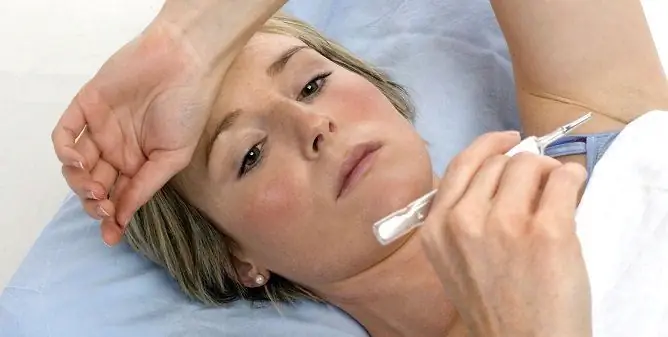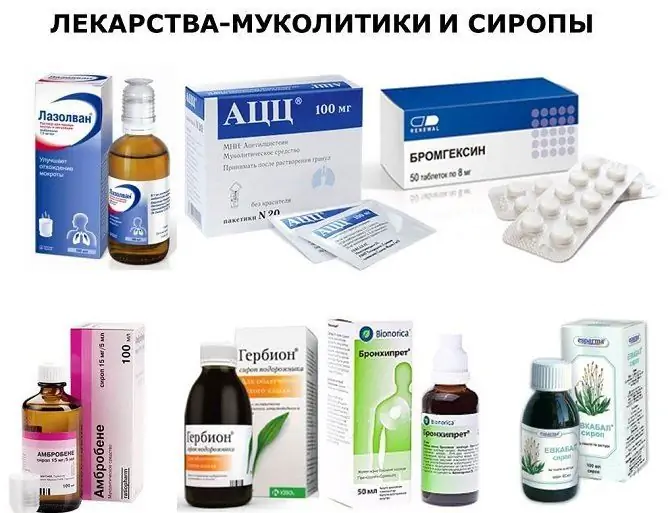Table of contents:
- Allergic bronchitis
- Causes and risk factors
- Forms of the disease
- Allergic bronchitis symptoms
- Diagnostics
- Allergic bronchitis treatment
- Potential consequences and complications
- Forecast
- Prevention

Video: Allergic Bronchitis In Children And Adults - Symptoms, Treatment

2024 Author: Rachel Wainwright | [email protected]. Last modified: 2023-12-15 07:39
Allergic bronchitis
The content of the article:
- Causes and risk factors
- Forms of the disease
- Allergic bronchitis symptoms
- Diagnostics
- Allergic bronchitis treatment
- Potential consequences and complications
- Forecast
- Prevention
Allergic bronchitis (respiratory allergy, asthmatic bronchitis) is an inflammation of the bronchi of large and medium diameter caused by exposure to allergens and manifested by edema and hypersecretion of the mucous membrane.
The disease differs from bronchial asthma in that there are no pronounced attacks of suffocation. But, despite this, pulmonologists and allergists consider allergic bronchitis in adults and children as a condition of pre-asthma.
Most often, the disease is observed in children under 9–12 years of age who have a burdened allergic history (allergic rhinitis, allergic diathesis, neurodermatitis, exudative dermatitis).

Allergic bronchitis is bronchitis of allergic origin
Causes and risk factors
Both infectious (microbes, viruses, fungi) and non-infectious agents entering the patient's body through the respiratory system or through the gastrointestinal tract can act as allergens that provoke the development of allergic bronchitis.
The most common non-infectious allergens are:
- food ingredients, especially stabilizers and preservatives;
- animal hair and dander;
- fluff;
- pollen of plants;
- house dust;
- industrial animal feed.

The allergens that provoke the development of bronchitis are usually infectious and non-infectious agents.
In children, allergic bronchitis can develop as a result of vaccine or drug allergies.
Often, the cause of the disease is polyvalent sensitization (hypersensitivity of the body to several substances at once).
Familial cases of allergic bronchitis are often detected, which indicates the presence of a hereditary predisposition to the disease.
In most cases, the infectious factor provoking the development of allergic bronchitis is staphylococcus aureus. It is it that is most often sown from sputum, and antibodies to this microorganism are found in the blood of patients suffering from this pathology.
In many cases, allergic bronchitis develops after suffering acute bronchitis, tracheitis, laryngitis, measles, whooping cough, pneumonia, ARVI, flu. In some patients, the disease develops against the background of gastroesophageal reflux disease.
In the pathological mechanism of the development of allergic bronchitis, the main role belongs to the increased reactivity (sensitivity) of the bronchial mucosa to the effects of certain allergens. The sites of the reaction between the allergen and antibodies are large and medium bronchi. The bronchioles are not drawn into the pathological process, which is why there are no pronounced attacks of suffocation in allergic bronchitis.
Forms of the disease
Depending on the type of immunopathological reaction underlying the development of the disease, infectious-allergic, atopic and mixed forms of allergic bronchitis are distinguished.
The atopic form of the disease is based on type I allergic reaction (IgE-mediated allergic reaction, immediate hypersensitivity). The infectious-allergic form develops as a result of delayed-type hypersensitivity (type IV allergic reaction, cell-mediated reaction). In the pathological mechanism of the formation of a mixed form of allergic bronchitis, allergic reactions of I and IV types take part.
Allergic bronchitis symptoms
Allergic bronchitis is chronic in nature with alternating periods of exacerbations and remissions. An exacerbation of the disease begins with an attack of coughing, which is provoked by crying, laughing or physical exertion. Often this attack is preceded by precursor symptoms, which include mild malaise, sore throat, serous rhinitis, nasal congestion.

Allergic bronchitis begins with an attack of coughing, which is provoked by laughing, crying, physical exertion
With an exacerbation of allergic bronchitis, the body temperature in most patients remains within normal limits, but sometimes it rises to subfebrile values (not higher than 38 ° C). In the first hours of the disease, the cough is dry, then it becomes moist.
Other symptoms of allergic bronchitis are:
- whistling forced noisy exhalation;
- expiratory dyspnea;
- labored breathing.
At the end of the attack, the patient is sputum, followed by significant relief.
An exacerbation of allergic bronchitis lasts from several hours to several weeks. If the disease is based on an allergy to non-infectious agents, then the elimination of contact with them (change of residence, change of season, change in diet) leads to a rapid cessation of coughing fits.
Allergic bronchitis is often combined with other manifestations of allergies (neurodermatitis, atopic dermatitis, hay fever, allergic rhinitis). With a prolonged course of the disease, some patients develop autonomic and neurological disorders (excessive sweating, lethargy, irritability).
Diagnostics
Diagnosis of allergic bronchitis is quite complicated and requires an analysis of the history data, the results of physical and a number of instrumental examinations of the patient, and allergy diagnostics. If allergic bronchitis is suspected, the patient should be consulted by an allergist-immunologist and a pulmonologist.
On examination, the chest is of normal volume. Above the lungs, when percussion, the box sound is determined. The auscultatory picture in exacerbation of allergic bronchitis is characterized by the presence of dry and wet wheezing of various sizes.
On radiographs of the lungs, an increase in the root pattern is noted, a thickening of the pulmonary pattern in the medial and vacuum in the lateral regions. These changes are assessed as latent emphysema.
With bronchoscopy, the observed picture is determined by the presence or absence of an infectious-inflammatory component in the pathological mechanism of the disease and can vary widely, ranging from practically unchanged mucous membrane to endoscopic signs of purulent endobronchitis.
In blood tests in patients with allergic bronchitis, eosinophilia, a decrease in the titer of complement, an increase in the level of histamine, immunoglobulins of class A and E.
To establish the cause of allergic bronchitis, scarification skin tests are performed, bacterial inoculation of sputum or bronchial lavage water is performed.

An important stage in the diagnosis of allergic bronchitis is skin tests to determine the allergen.
In order to assess the course of allergic bronchitis, the function of external respiration must be examined (spirometry, pneumotachography, plethysmography, gas analysis of external respiration, peak flowmetry).
Allergic bronchitis treatment
Treatment of allergic bronchitis is complex. The therapy regimen is developed individually for each patient. If an allergen is identified, a long-term, for at least two years, specific hyposensitization is carried out. The method consists in injecting the patient with an allergen in appropriate dilutions. Specific hyposensitization significantly reduces the risk of transformation of the disease into bronchial asthma, increasing the body's resistance to the effects of this allergen.
For the purpose of non-specific desensitization of the patient's body, injections of histoglobulin are prescribed.

Histaglobulin injections are indicated as a hyposensitizing treatment for allergic rhinitis
To reduce the severity of allergic reactions, antihistamines are used. With infectious-allergic bronchitis at the time of exacerbation, antibiotics may be prescribed. In addition, vitamins, mucolytics, antispasmodics and bronchodilators are included in the complex therapy of the disease.
To restore the local ionic balance, reduce the viscosity of sputum and improve trophic processes in the bronchial mucosa, alkaline and sodium chloride inhalations and nebulizer therapy are used. Physiotherapeutic procedures (electroacupuncture, acupuncture, physiotherapy exercises, therapeutic swimming, Charcot douche, percussion massage of the chest, general or local massage of the chest, ultraviolet irradiation, medicinal electrophoresis) have a good effect in allergic bronchitis.
In the period of remission of allergic bronchitis, patients are recommended to have a spa treatment.
Potential consequences and complications
With frequent exacerbations of allergic bronchitis, the risk of developing bronchial asthma is high.
A long-term exacerbation leads to the formation of a chronic form of allergic bronchitis, and can also cause a number of complications:
- pneumonia;
- obstructive bronchitis;
- massive lung atelectasis;
- bullous lung disease;
- bronchopulmonary shock.
Quite often, an exacerbation of allergic bronchitis is combined with systemic manifestations of an allergic reaction (Quincke's edema, anaphylactic shock).
Forecast
In general, the prognosis for life with allergic bronchitis is favorable. However, in 25-30% of patients, the disease is transformed over time into bronchial asthma.
Prevention
To prevent the development of allergic bronchitis and the occurrence of its exacerbations, it is necessary:
- adhere to a hypoallergenic diet. Products that provoke the development of allergies (citrus fruits, chocolate, honey, smoked meats, milk, etc.) are excluded from the diet;
- fight house dust, one of the most powerful allergens. To this end, you should: carry out wet cleaning in the room every day, replace feather and down pillows and mattresses with hypoallergenic ones, get rid of carpets, soft toys, heavy curtains and other objects on which dust is deposited in large quantities;
- observe the water regime. Drinking plenty of fluids helps to thin the phlegm and facilitates its excretion from the bronchi. It is best to use herbal teas, alkaline mineral waters;
- quit smoking. Tobacco itself is not an allergen, but tobacco smoke irritates the mucous membrane of the respiratory tract, increasing its sensitivity to other aggressive agents.
With an exacerbation of seasonal allergies, the patient is advised to go outside as little as possible. The windows should be kept closed in the room, wet cleaning should be performed daily. When using the air conditioner, it must be equipped with a special filter that captures and retains dust particles and other allergens.
YouTube video related to the article:

Elena Minkina Doctor anesthesiologist-resuscitator About the author
Education: graduated from the Tashkent State Medical Institute, specializing in general medicine in 1991. Repeatedly passed refresher courses.
Work experience: anesthesiologist-resuscitator of the city maternity complex, resuscitator of the hemodialysis department.
The information is generalized and provided for informational purposes only. At the first sign of illness, see your doctor. Self-medication is hazardous to health!
Recommended:
How To Distinguish Bronchitis From Pneumonia In Children And Adults At Home

It is possible to distinguish bronchitis from pneumonia by a number of clinical signs, there are differences in the etiology of diseases, but both diseases require therapy under the supervision of a doctor
Mustard Plasters For Bronchitis: Is It Possible To Put On Adults And Children, Reviews

Mustard plasters for bronchitis are very popular and have proven themselves as a means of additional therapy for both adults and children
Temperature With Bronchitis: How Many Days Do Children And Adults Have

A significant increase in temperature with bronchitis is rare and usually indicates the development of complications. Low-grade fever is more common
Medicines For Bronchitis In Adults And Children: A List Of The Best Drugs

The correct choice of medicines for bronchitis allows you to cure this disease in the shortest possible time and avoid adverse consequences
Acute Obstructive Bronchitis In Adults And Children: Microbial Code 10, Treatment

Acute obstructive bronchitis is an inflammatory disease of the bronchi, accompanied by the development of expiratory dyspnea, cough, and noisy wheezing






